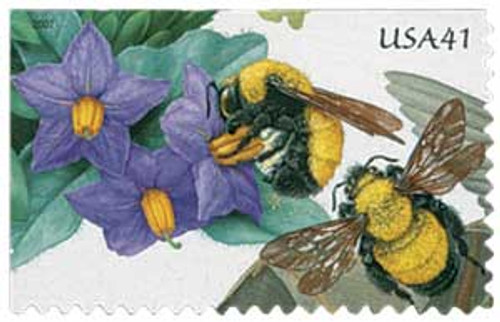
2007 41c Pollination: Hummingbird and Trumpet Flower
# 4154 - 2007 41c Pollination: Hummingbird and Trumpet Flower
$0.45 - $3.75
U.S. #4154
2007 41¢ Hummingbird
Pollination
2007 41¢ Hummingbird
Pollination
Issue Date: June 29, 2007
City: Washington, DC
Quantity: 420,000,000
City: Washington, DC
Quantity: 420,000,000
Printed By: Ashton-Potter (USA) Ltd
Printing Method: Lithographed
Perforations: Serpentine die cut 11
Color: Multicolored
One third of the world's food supply requires insect pollination, and 80% of those crops are pollinated by bees. Pollination occurs as bees visit flowers for nourishment, eating nectar for energy and pollen for protein. Pollen sticks to the bees' leg hairs and is brushed off as the bees move from flower to flower, fertilizing the plants.
Birds help promote plant survival in three ways. They pollinate plants as they move from flower to flower, feeding on nectar. They help create new plants by eating fruit and dispersing the seeds. They also eat insects that have the potential to damage plants.
U.S. #4154
2007 41¢ Hummingbird
Pollination
2007 41¢ Hummingbird
Pollination
Issue Date: June 29, 2007
City: Washington, DC
Quantity: 420,000,000
City: Washington, DC
Quantity: 420,000,000
Printed By: Ashton-Potter (USA) Ltd
Printing Method: Lithographed
Perforations: Serpentine die cut 11
Color: Multicolored
One third of the world's food supply requires insect pollination, and 80% of those crops are pollinated by bees. Pollination occurs as bees visit flowers for nourishment, eating nectar for energy and pollen for protein. Pollen sticks to the bees' leg hairs and is brushed off as the bees move from flower to flower, fertilizing the plants.
Birds help promote plant survival in three ways. They pollinate plants as they move from flower to flower, feeding on nectar. They help create new plants by eating fruit and dispersing the seeds. They also eat insects that have the potential to damage plants.










